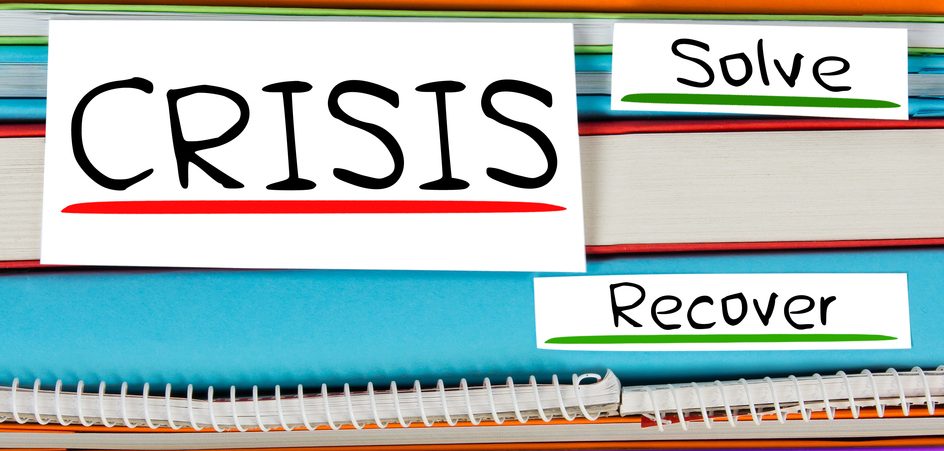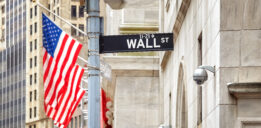Capitalism Has Worked, But It’s Now Leading Us to Financial Collapse
Capitalism has proven to be the system that can claim to have created the most prosperity. But it has also created, or at least has encouraged, considerable injustice. The widespread prosperity is now eroding while injustice is increasing. Meanwhile, stock exchanges are teetering, hesitating back and forth. Lately, they have been trending more toward “back.” Then again, the financial crisis started in 2008 only appears to have finished.
The bull market that started in 2009 and pushed the Dow Jones to 26,000+ may give the impression that the American—indeed, the global—economy has recovered. The financial crisis is far from over, however. Its roots are deeper than 2008, going back to a specific historical event that occurred at the end of 1989 and the start of 1990: the fall of the Berlin Wall. That event gave the final blow to the economic system that was responsible for generating the most intense and widespread period of prosperity in recorded history.
Finance Has Become More Important Than the Actual Economy
The inherent weakness in the economic system rests in the fact that finance and speculation have superseded productive activities. The latter tends to spread wealth across a wider section of the population. The gains of finance don’t stretch beyond a handful of individuals. Speculation both generates and thrives on weakness. This is why we could see a major stock market crash in 2018 and a re-emergence of the 2008 financial crisis.
What Could Happen in the Next Few Months?
The financial markets are resting on ever-weaker foundations. One of the reasons for the weakness is that the causes and nature of the 2008 financial crisis have never been adequately discussed or explored. Few doubt that the easing of financial regulations in the 1990s are a factor, especially President Bill Clinton’s repeal of part of the Glass-Steagall Act. The latter step was under pressure from Clinton’s aides in 1999. (Source: “Wall Street deregulation pushed by Clinton advisers, documents reveal,” The Guardian, April 19, 2014.)
Glass-Steagall deterred banks from taking on too much risk. The 1999 changes to the act allowed insurance companies, investment banks, and retail banks to merge. But does such deregulation alone explain the crisis? No, it’s merely one minor aspect.
Some might argue that deregulation, just as any measure that legalizes and co-opts activities, will lead to degradation if it renders some excesses (vices) tolerable, even praised. Society in general accepts the otherwise-tame and polite corporate executive when he/she has has a little too much to drink. Alcohol consumption is legal and even encouraged, within reasonable limits, in polite society.
Thus, the concept works similarly in finance: a little regulation can help certain kinds of financial speculation (an elegant term for what most people otherwise define as “gambling”) to continue.
A Few Gained While Millions Lost
The worst aspects of the 2008 financial crisis from a moral standpoint is that many people who had nothing to do with stocks and the financial markets suffered the consequences of the actions of Wall Street players. Many of the latter survived with their wealth intact, yet millions of people all over the world lost their jobs, savings, and livelihoods.
When the big banks that created the financial mess got their bailout billions and got their groove back, none of that wealth trickled down to those who lost through no fault of their own.
The regulation argument is a mere mask to cover the odor emanating from the core. What many are refusing to admit is that the end of the welfare or Keynesian model, the one that inspired President Franklin Delano Roosevelt’s “New Deal,” culminating in President Lyndon B. Johnson’s “Great Society,” has unleashed a wave of greed, which ultimately ends up harming most of us, even the super-rich. This is why the collapse of the Berlin Wall is the crucial factor in explaining the 2008 financial crisis and its imminent resurrection.
What Did We Lose Along with the Bricks in the Wall?
There’s little doubt that the collapse of the Berlin Wall was a seminal moment in the 20th century. Certainly, in my lifetime, few events have been as dense in hope for a better future for all peoples. The fall of the wall signaled the end of the Cold War. Russia was now a friend of the West. But, as winners often do, we in the West behaved arrogantly.
The End of History?
Such was the hubris that serious scholars like Francis Fukuyama proclaimed that the collapse of the Berlin Wall, symbolizing the eventual collapse of the Soviet Union (USSR) in 1992, marked “the end of history.” The implication was that the Western capitalist model had triumphed and there was nothing to adopt from the vanquished.
In fact, there was a lot to learn. Much of the capitalist system’s success—its ability to spread wealth among as large a section of the population as possible—was borrowed from behind the Iron Curtain.
The Soviet Union survived the 1929 stock market crash and the Great Depression that it produced. Thus, western governments, including the ones experimenting with fascism, borrowed a key idea from the Communists, adapting it to the free-market system.
This central idea is not especially revolutionary, but people like Roosevelt thought that rejecting it could spark a communist revolution in the United States. It proposes that the state is a necessary ingredient in the capitalist system. The state sets the general guidelines and rules within which the market operates. The state would intervene to create as level a playing field for said markets, absorbing its shocks and encouraging a distribution of the rewards through general welfare mechanisms.
The wealthy benefit as well, because more equitable wealth distribution reduces social and class differences, making society safer. What good is it to have a nice house, nice jewels, and a nice car if you constantly have to worry about protecting them from your fellow citizens?
The 2008 Financial Crisis and the Next One Have Their Roots in the 1970s
In the 1970s, the consensus model ended. First Margaret Thatcher in the United Kingdom and then Ronald Reagan in the United States started to dismantle the welfare state through deregulation and privatization. But, just as the perfect socialist system is a mirage that exists only in theory, so is a perfect capitalist system. After all, the ideal capitalism that Adam Smith envisaged in The Wealth of Nations was responsible and regulated. Neither the communists nor the capitalists have ever fulfilled their ideals. That’s where the West took the wrong turn.
Instead of using the collapse of communism—or, rather the collapse of the effort to achieve communism in the USSR—as an occasion to re-examine its own flaws, the West marched straight ahead, doubling down on the neoliberal policies of the Thatcher-Reagan era. The new No. 1 enemy of the West was no longer the USSR, socialism, or communism. The various political groups that still subscribed to those concepts evolved, embracing even such things as privatization of state assets. The new enemy was public debt.
In the name of reducing public debt, governments cut back on the social programs that served as the foundation of the prosperity that led the West to win the ideological struggle at the heart of the Cold War. Governments were, in effect, shifting risks back to the people, just as in the period that culminated in the 1929 market crash.
Public Debt is Matter of Perspective
There’s nothing wrong with keeping the public debt under control, yet the problem of the neoliberal philosophy that has guided left- and right-wing governments in the post-Berlin Wall world is that it has placed the responsibility for public debt fully on the shoulders of the welfare state.
It doesn’t matter whether Democrat or Republican, despite the rhetoric, both parties have racked up debt (often through military spending and related adventures). And both parties have dismantled the welfare state, putting nothing in its place to absorb the shock. Let nobody forget that it was none other than President Clinton who lived and breathed the mantra of reducing spending on social shock absorbers. His followers, George W. Bush and Barack Obama, acted no differently.
The main problem related to cuts in government spending is related to income distribution. This has put pressure on all income, to the disadvantage of the middle classes and working classes. Wages throughout the leading economies in the world are stuck where they were before the 2008 financial crisis. In the United States, real wages have stagnated since the 1973 oil crisis, which was one of the triggers of neoliberalism. (Source: “Why Wages Aren’t Growing in America,” Harvard Business Review, October 24, 2017.)
This stagnation has led to a very real debt crisis in America (and elsewhere). The stale wages have gradually reduced the real purchasing power of the middle classes that acted as the pillar of the post-World War II economic miracle. To compensate, these same classes have sharply increased borrowing, taking on too much debt. This huge redistribution of income from bottom to top is the very opposite of what President Reagan promised in his “supply-side economics” (otherwise known as “trickle-down economics”).
The Stagnation of Wealth
The rich who accumulated the wealth then lent the money back to the middle classes, many of whose members have joined the low-income or “poor” club. The sub-prime mortgage crisis was a micro-version of this same model; a transfer of risk from the banks and the rich to the rest of the public.
The mechanism blew up, exposing those who were responsible for its construction. But they were bailed out, given yet another chance to gamble. That was the main resolution to the 2008 financial crisis.
While the financial engineers played “Monopoly” with other people’s money, the corporations took advantage of deregulation in order to shift their activities and jobs abroad. The goal was to maximize profits and please shareholders.
In 2018, the markets have reach a peak, and the economy is still functioning according to the principles that led to the last major stock market crash and undeclared economic depression.
Only an overhaul of the neoliberal economics that have characterized the past 40-or-so years can truly make us feel safer from further heavy financial shocks. It took such an approach to lead the U.S. out of the Great Depression in the 1930s. This needs a shift in thinking.
Even some self-declared left-leaning intellectuals have bought into the neoliberal model. But this version of “business as usual,” just like communism or socialism left to run rampant, only leave crises and problems in its wake.
The subprime mortgage crisis was triggered because a government found it politically expedient for banks to issue low-interest loans to sectors of society that would never be able to pay back those loans. The banks were happy to take on the risk because the government guaranteed those loans, among other mechanisms. The result was that the loans further pauperized the weaker classes.
But another result that we all experience is that finance has stopped being a tool of the economy; it has become the economy. And finance has a necessary speculative element at its very core. The real solution to future financial crises and shocks may come after the next Wall Street disaster, which is approaching.
President Obama was inexperienced and had to face the effects of the crisis immediately upon being sworn in. A more seasoned president, like Roosevelt, would have used the 2008 stock market crash to launch a series of reforms extending far beyond the realm of bank regulations and focusing on job creation and infrastructure spending. President Trump has seen some of this light, but the December 2017 tax cuts suggest that he has not offered the right prescription.
The tax cuts will encourage more, rather than less, speculation on Wall Street, pushing the markets closer to the edge and the rest of us closer to economic collapse.






